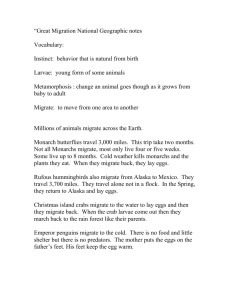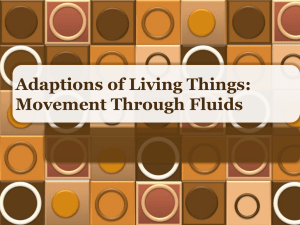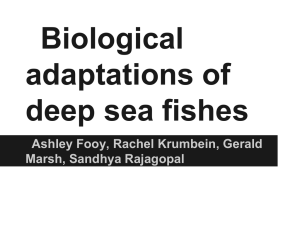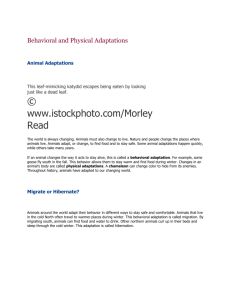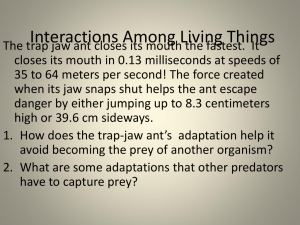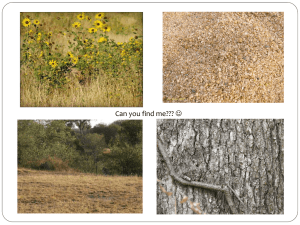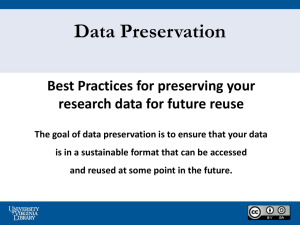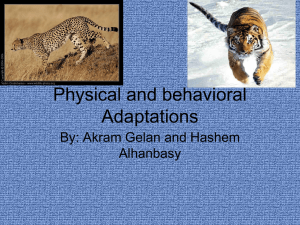p. 215 – Plant adaptations
advertisement
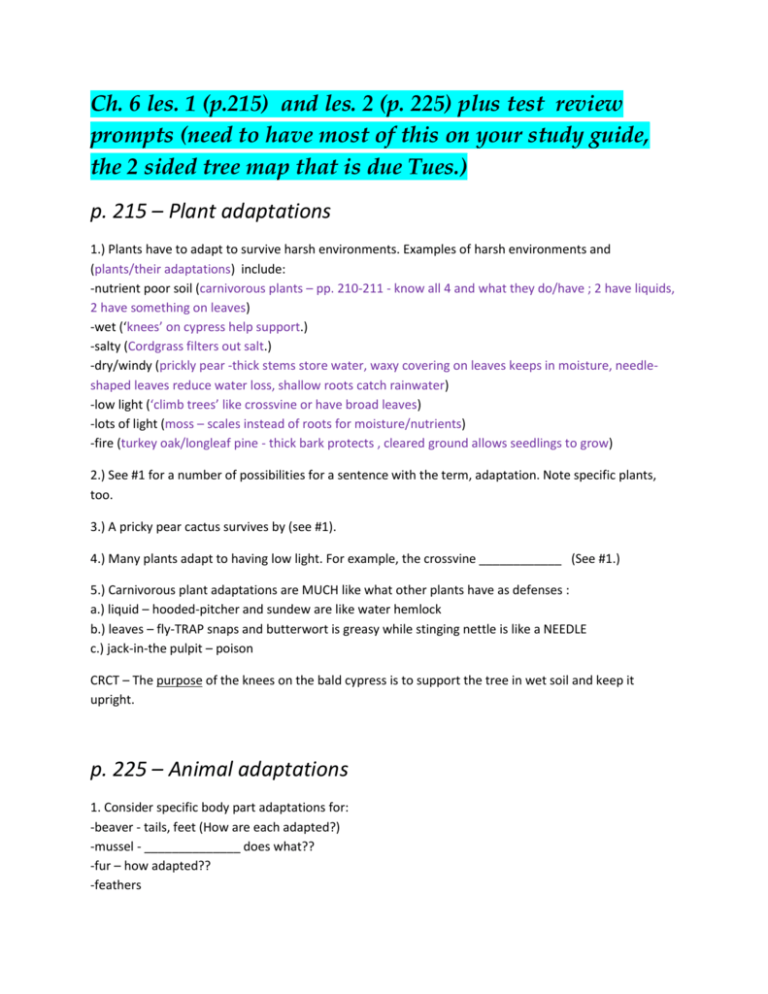
Ch. 6 les. 1 (p.215) and les. 2 (p. 225) plus test review prompts (need to have most of this on your study guide, the 2 sided tree map that is due Tues.) p. 215 – Plant adaptations 1.) Plants have to adapt to survive harsh environments. Examples of harsh environments and (plants/their adaptations) include: -nutrient poor soil (carnivorous plants – pp. 210-211 - know all 4 and what they do/have ; 2 have liquids, 2 have something on leaves) -wet (‘knees’ on cypress help support.) -salty (Cordgrass filters out salt.) -dry/windy (prickly pear -thick stems store water, waxy covering on leaves keeps in moisture, needleshaped leaves reduce water loss, shallow roots catch rainwater) -low light (‘climb trees’ like crossvine or have broad leaves) -lots of light (moss – scales instead of roots for moisture/nutrients) -fire (turkey oak/longleaf pine - thick bark protects , cleared ground allows seedlings to grow) 2.) See #1 for a number of possibilities for a sentence with the term, adaptation. Note specific plants, too. 3.) A pricky pear cactus survives by (see #1). 4.) Many plants adapt to having low light. For example, the crossvine ____________ (See #1.) 5.) Carnivorous plant adaptations are MUCH like what other plants have as defenses : a.) liquid – hooded-pitcher and sundew are like water hemlock b.) leaves – fly-TRAP snaps and butterwort is greasy while stinging nettle is like a NEEDLE c.) jack-in-the pulpit – poison CRCT – The purpose of the knees on the bald cypress is to support the tree in wet soil and keep it upright. p. 225 – Animal adaptations 1. Consider specific body part adaptations for: -beaver - tails, feet (How are each adapted?) -mussel - ______________ does what?? -fur – how adapted?? -feathers -an insect’s weight/legs/mouth parts (think of the insect that ‘strides’ on water surface) -gator – Can you name 5? 2.Know these terms and also how they are related to one another : talons and prey 3 possible examples --When a flying predator is ready to catch its prey for a meal, it will grab the prey by its talons and carry it to where the meal will be eaten. --An example of prey would be a fish being scooped up by the talons of a bird that wants to eat it. --Since talons are curved, they allow predators to hold onto their prey until they can get to where it is safe to eat. CONSIDER THIS: Are talons only found on predator birds?? 4. Adaptations help us understand these things about animals: -movement – know migration (what does it and several reasons why) -diet -habitat -behavior 5.If you are observing more birds at a certain time of the year, they are most likely migrating or have migrated. Generally, they will migrate when an area is warmer because food is easier to find. For example, Maine will see some birds migrate in the late spring because the summer months are warm there, but the birds will get out of town in early fall. On the other hand, areas like Georgia and Florida may see migrated birds throughout the winter season because those winters are usually mild (not too cold). **Our book focuses on migration with animals going to a warmer region, particularly for food – but migration is truly about movement. It includes when they go in reverse – like hummingbirds that move to warmth for the winter then they migrate BACK to the northern climates for a summertime. A polar bear migrates to cooler areas when its location gets warm – just the opposite of a bird! See below the CRCT response for a sample of just a few animals and why they migrate. CRCT – Looking like another animal is mimicry. Mimicry may be how an animal looks OR acts like another animal to trick it. It may copy for protection OR –now and then - use mimicry as an advantage to attack!! Camouflage is an ADAPTATION – not a behavior . Either you have camouflage to hide, or you don’t. Here is a cool website with more on mimicry: http://www.alleghany.k12.va.us/animal%20adaptation%20webpage/animal_mimicry.htm BACK TO MIGRATING Reasons to Move Some animals travel relatively short distances to find food or more favorable living or breeding conditions. Most animals that migrate do so to find food or more livable conditions. Some animals migrate to breed. The Atlantic Salmon begins its life in a river and migrates downstream to the ocean. After several years, it heads back upstream to lay eggs and begin the cycle all over again. Some crustaceans also migrate for breeding. In many species of crabs, the females will move into shallow coastal waters to mate and lay her eggs, then they return to deeper ocean waters. Frogs and toads often move very short distances to breeding ponds and lakes to lay their eggs. Some sea turtles, like the loggerhead, return year-after-year to the same sandy beach on which they hatched to Sometimes animals migrate to find a place to hibernate. Little brown bats live in trees in warm months, then in cold weather they migrate to caves where it is warmer. Image Credits: Clipart.com unless otherwise noted lay their eggs.
